Dear Zazie, Here is Mac Tag‘s Lovers’ Chronicle to his muse. Follow us on twitter @cowboycoleridge. Rhett
The Lovers’ Chronicle
Dear Muse,
© copyright 2020 mac tag/cowboy coleridge all rights reserved
© copyright 2019 mac tag/cowboy coleridge all rights reserved
i shall find, day by day,
in all thoughts and things,
the heart of friendship
outside of you,
what matters
from the first glance,
remain forever
were there some way
to put into words
the essential nature
of the woven texture
of our time together
© copyright 2018 mac tag/cowboy coleridge all rights reserved
an uninterrupted stream of you
a flow never ceasin’,
and the quaverin’
continues
when we danced,
‘neath the High Plains stars,
i remember, i remember
how those days fleeted by
and sleep
will not come
for i fancy
those long ago
embraces
© copyright 2017 Mac tag/cowboy Coleridge
In the late 1640s Rembrandt began a relationship with the much younger Hendrickje Stoffels, who had initially been his maid. In 1654 they had a daughter. Hendrickje received a summons from the Reformed Church to answer the charge “that she had committed the acts of a whore with Rembrandt the painter”. She admitted this and was banned from receiving communion. Rembrandt was not summoned to appear for the Church council because he was not a member of the Reformed Church. The two were considered legally wed under common law.
Rembrandt was buried as a poor man in an unknown grave in the Westerkerk. It was in a numbered ‘kerkgraf’ (grave owned by the church) somewhere under a tombstone in the church. After twenty years, his remains were taken away and destroyed, as was customary with the remains of poor people at that time.
Gallery
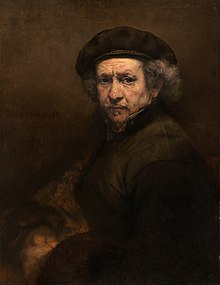
Self-Portrait with Beret and Turned-Up Collar (1659), National Gallery of Art, Washington, D.C.



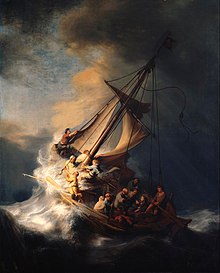


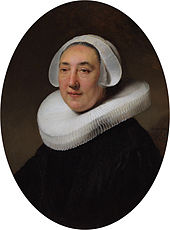



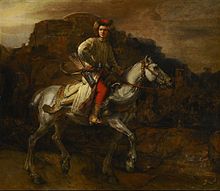



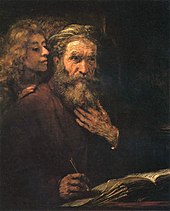
-

A young Rembrandt, c. 1628, when he was 22. Partly an exercise in chiaroscuro. Rijksmuseum
-
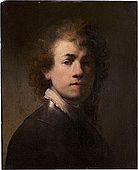
Self-portrait, c. 1629; Germanisches Nationalmuseum, Nuremberg
-

Self-portrait, 1630, Nationalmuseum, Stockholm
-

Self-Portrait with Velvet Beret and Furred Mantle 1634
-
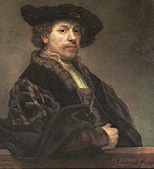
Self-portrait, 1640, at 34 years old. National Gallery, London
-
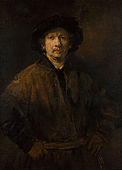
Self-Portrait, oil on canvas, 1652. Kunsthistorisches Museum, Vienna
-

Self-portrait, Vienna c. 1655, oil on walnut, cut down in size. Kunsthistorisches Museum, Vienna
-
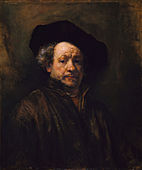
Self-Portrait, 1660
-

Self-Portrait as Zeuxis, c. 1662. One of 2 painted self-portraits in which Rembrandt is turned to the left. Wallraf-Richartz Museum, Cologne
-

Self-portrait, 1669.
-

Self-portrait, dated 1669, the year he died, though he looks much older in other portraits. National Gallery, London
-

The Stoning of Saint Stephen, 1625, The first painting by Rembrandt, painted at the age of 19. It is currently kept in the Musée des Beaux-Arts de Lyon.
-

Jeremiah Lamenting the Destruction of Jerusalem, c. 1630
-

The Philosopher in Meditation, 1632
-

Anatomy Lesson of Dr. Nicolaes Tulp, 1632
-

Abraham and Isaac, 1634
-
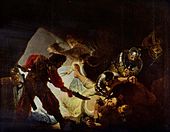
The Blinding of Samson, 1636, which Rembrandt gave to Huyghens
-
Saskia in red hat, 1635
-
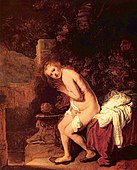
Susanna, 1636
-
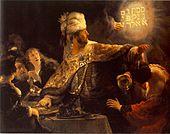
Belshassar’s Feast, 1636-8
-
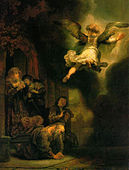
The Archangel leaving Tobias, 1637
-
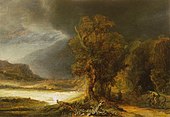
The Landscape with Good Samaritan, 1638
-

Susanna and the Elders, 1647
-

The Mill, 1648
-
An Old Man in Red, 1652-1654
-

Aristotle with a Bust of Homer, 1653, Metropolitan Museum of Art in New York
-

Young Girl at the Window, 1654
-
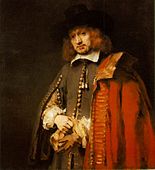
Portrait of the later mayor Jan Six, a wealthy friend of Rembrandt, 1654
-
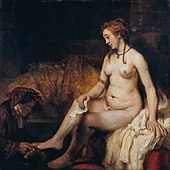
Bathsheba at Her Bath, modeled after Hendrickje, 1654
-

Woman Bathing in a Stream, 1655
-

Woman in a Doorway, 1657-1658
-

-
Ahasuerus and Haman at the Feast of Esther, 1660
-

Saint Bartholomew, 1661, J. Paul Getty Museum
-
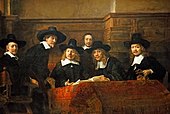
The Syndics of the Drapers’ Guild, 1662
-
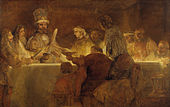
The Conspiracy of Claudius Civilis (cut-down), 1661–62
-

Jacob Blessing the Sons of Joseph, 1656
-

The Return of the Prodigal Son, detail, c. 1669
-
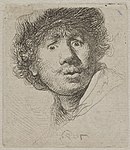
Self-portrait in a cap, with eyes wide open, etching and burin, 1630
-

Self-portrait, pen and brush and ink on paper, c. 1628-1629
-

Role-playing in Self-portrait as an oriental Potentate with a Kris, etching, 1634
-

The Hundred Guilder Print, c. 1647–1649,
-

Suzannah and the Elders, drawing, 1634
-

Self-portrait with Saskia, etching, 1636
-
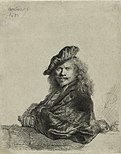
Self-portrait leaning on a Sill, etching, 1639
-
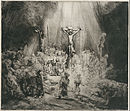
The Three Crosses, etching by Rembrandt, 1653, State III of V
-

Christ and the woman taken in adultery, drawing
-

Virgin and Child with a Cat, 1654. Original copper etching plate above, example of the print below
-

An elephant 1637
-
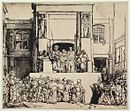
Christ presented to the People, drypoint, 1655, State I of VIII
Mac Tag

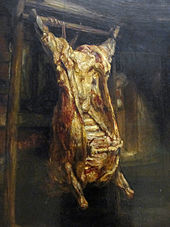


No Comments on "The Lovers’ Chronicle 15 July – reverie – art by Rembrandt"